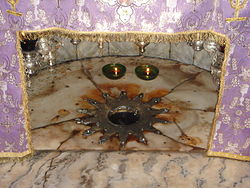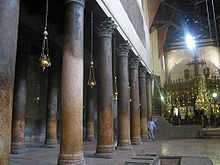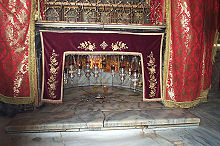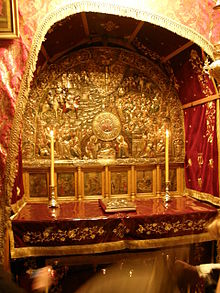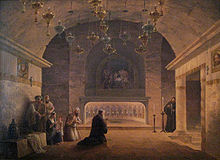- Church of the Nativity
-
This silver star, beneath the altar in the Grotto of the Nativity, marks the spot believed to be the Birthplace of Jesus.

The Church of the Nativity (Arabic: كنيسة المهد) in Bethlehem is one of the oldest continuously operating churches in the world. The structure is built over the cave that tradition marks as the birthplace of Jesus of Nazareth, and thus it is considered sacred by Christians. The site is also revered by followers of Islam (see Jesus in Islam).
Contents
History
The antiquity of this tradition is attested by the Christian apologist Justin Martyr (c. 100 - 165), who noted in his Dialogue with Trypho that the Holy Family had taken refuge in a cave outside of town:
Joseph took up his quarters in a certain cave near the village; and while they were there Mary brought forth the Christ and placed Him in a manger, and here the Magi who came from Arabia found Him.(chapter LXXVIII).
Origen of Alexandria (185 AD–ca. 254) wrote:
In Bethlehem the cave is pointed out where He was born, and the manger in the cave where He was wrapped in swaddling clothes. And the rumor is in those places, and among foreigners of the Faith, that indeed Jesus was born in this cave who is worshipped and reverenced by the Christians. (Contra Celsum, book I, chapter LI).
The first basilica on this site was begun by Saint Helena, the mother of the Emperor Constantine I. Under the supervision of Bishop Makarios of Jerusalem, the construction started in 327 and was completed in 333. That structure was burnt down in the Samaritan Revolt of 529.
The current basilica was rebuilt in its present form in 565 by the Emperor Justinian I. When the Persians under Chosroes II invaded in 614, they unexpectedly did not destroy the structure. According to legend, their commander Shahrbaraz was moved by the depiction inside the church of the Three Magi wearing Persian clothing, and commanded that the building be spared. The Crusaders made further repairs and additions to the building during the Latin Kingdom of Jerusalem with permission and help given by the Byzantine Emperor, and the first King of Jerusalem was crowned in the church. Over the years, the compound has been expanded, and today it covers approximately 12,000 square meters. The church was one of the direct causes for French involvement in the Crimean War against Russia.
The church is administered jointly by Roman Catholic, Greek Orthodox and Armenian Apostolic authorities. All three traditions maintain monastic communities on the site.
Compound
The structure is actually a combination of two churches, with a crypt beneath—the Grotto of the Nativity—where Jesus was born:
- The main Basilica of the Nativity is maintained by the Greek Orthodox Patriarchate of Jerusalem. It is designed like a typical Roman basilica, with five aisles (formed by Corinthian columns) and an apse in the eastern end, where the sanctuary is. The church features golden mosaics covering the side walls, which are now largely decayed. The basilica is entered through a very low door, called the "Door of Humility." The original Roman style floor has since been covered over, but there is a trap door in the modern floor which opens up to reveal a portion of the original mosaic floor. The church also features a large gilded iconostasis, and a complex array of lamps throughout the entire building. The wooden rafters were donated by King Edward IV of England. The same king also donated lead to cover the roof; however, this lead was later taken by the Ottoman Turks, who melted it down for ammunition to use in war against Venice. Stairways on either side of the Sanctuary lead down by winding stairs to the Grotto.
- The adjoining Church of St. Catherine, the Roman Catholic Church, was built in a more modern Gothic revival style, and has since been further modernized according to the liturgical trends which followed Vatican II. This is the church where the Latin Patriarch of Jerusalem celebrates Midnight Mass on Christmas Eve. Certain customs still observed in this Midnight Mass predate Vatican II, but must be maintained because the "status quo" (the customs, rights and duties of the various church authorities that have custody of the Holy Places) was legally fixed by a firman in 1852, under the Ottoman Empire, that is still in force to this day.
- The Bas-relief of the Tree of Jesse is a large work by well-known religious sculptor Czesław Dźwigaj which was recently incorporated into the Church of St. Catherine as a gift of Pope Benedict XVI during his trip to the Holy Land in 2009. Measuring in at 3.75 by 4 metres (12.3 by 13 ft), its corpus represents an olive tree figuring as the Tree of Jesse displaying Christ's lineage from Abraham through St. Joseph along with other biblical motifs. Situated along the passage used by pilgrims making their way to the Grotto of the Nativity, the bas relief also incorporates symbolism from the Old Testament. The upper portion is dominated by a crowned figure of Christ the King in an open armed pose blessing the Earth.[1]
- The Grotto of the Nativity, an underground cave located beneath the basilica, enshrines the site where Jesus is said to have been born. The exact spot is marked beneath an altar by a 14-pointed silver star set into the marble floor and surrounded by silver lamps. This altar is denominationally neutral, although it features primarily Armenian Apostolic influences. Another altar in the Grotto, which is maintained by the Roman Catholics, marks the site where traditionally Mary laid the newborn Baby in the manger.
- Numerous Chapels are found in the compound as well, including the Chapel of Saint Joseph, commemorating the angel's appearance to Joseph, commanding him to flee to Egypt (Matthew 2:13); the Chapel of the Innocents, commemorating the children killed by Herod (Matthew 2:16-18); and the Chapel of Saint Jerome, where traditionally he translated the Bible into Latin (the Vulgate).
- Manger Square, a large paved courtyard in front of the Church, is the site where crowds gather on Christmas Eve to sing Christmas carols in anticipation of the midnight services.
Christmas celebrations
The Greek Orthodox Patriarchate of Jerusalem and the Armenian Apostolic Church follow the Julian Calendar liturgically, whereas the Roman Catholic Church follows the modern Gregorian Calendar. Thus Christmas Eve services for the Eastern and Western confessions will be held on different days. The Roman Catholic Church will celebrate the Nativity on December 25; the Orthodox Church will celebrate the Nativity on January 7.
Preservation concerns
The basilica was placed on the 2008 Watch List of the 100 Most Endangered Sites by the World Monuments Fund:
The present state of the church is worrying. Many roof timbers are rotting, and have not been replaced since the 19th century. The rainwater that seeps into the building not only accelerates the rotting of the wood and damages the structural integrity of the building, but also damages the 12th-century wall mosaics and paintings. The influx of water also means that there is an ever-present chance of an electrical fire. If another earthquake were to occur on the scale of the one of 1834, the result would most likely be catastrophic. ... It is hoped that the listing will encourage its preservation, including getting the three custodians of the church - the Greek Orthodox Church, the Armenian Orthodox Church, and the Franciscan order - to work together, which has not happened for hundreds of years. The Israeli government and the Palestinian Authority would also have to work together to protect it.
[citation needed] [2] In 2010, the Palestinian Authority announced that a multi-million dollar restoration program was imminent.[3][dead link]
Shrine of Adonis-Tammuz
According to some scholars[4], the church is built over a cave that was originally a shrine to Adonis-Tammuz.
The Church Father Jerome, who died in Bethlehem in 420, reports in addition that the holy cave was at one point consecrated by the heathen to the worship of Adonis, and a pleasant sacred grove planted before it, to wipe out the memory of Jesus. Modern mythologists, however, reverse the supposition, insisting that the cult of Adonis-Tammuz originated the shrine and that it was the Christians who took it over, substituting the worship of their own God.[5]
Burials
- Saint Paula, beneath the church
Gallery
Notes
- ^ "Płaskorzeźba w darze" (in Polish). Dziennik Polski. 13 maja 2009. http://www.dziennikpolski24.pl/Artykul.100+M5d4c87a1956.0.html. Retrieved May 15, 2009.[dead link]
- ^ http://www.wmf.org/project/church-holy-nativity
- ^ http://www.kansascity.com/2010/10/25/2350734/restoration-planned-for-bethlehem.html
- ^ Giuseppe Ricciotti, Vita di Gesù Cristo, Tipografia Poliglotta Vaticana (1948) p. 276 n.
- ^ Marcello Craveri, The Life of Jesus, Grove Press (1967) pp. 35-36
See also
- Nativity of Jesus
- Early Christian art and architecture
- Mosque of Omar in Bethlehem, located nearby
- Oldest churches in the world
- Palestinian Christians
- Siege of the Church of the Nativity in Bethlehem
External links
- BBC article about the Church of the Nativity
- Manger Square
- Photo gallery of Bethlehem and the Church of the Nativity
- The World Monuments Fund's 2008 Watch listing for the Church
Coordinates: 31°42′15.50″N 35°12′27.50″E / 31.704306°N 35.207639°E
Religious Sites in the Palestinian Authority Ancient synagogue (Gaza) · Burqin Church · Church of the Nativity · Mosque of Omar (Bethlehem) · Cave of the Patriarchs† · Joseph's Tomb · Jacob's Well · Al-Khadra Mosque · Great Mosque of Nablus · An-Nasr Mosque · Tomb of Lazarus (al-Eizariya) · Tomb of Joshua · Great Mosque of Gaza · Monastery of the Temptation · Shalom Al Yisrael Synagogue · Mount Gerizim · Mount Ebal
† Although the Cave of the Patriarchs rests in Area A of the West Bank, access to the site is controlled by Israel.Categories:- Buildings and structures in Bethlehem
- Churches in the West Bank
- Basilica churches in Asia
- Eastern Orthodox church buildings
- Roman Catholic churches in Asia
- Armenian Apostolic churches
- Christmas events and celebrations
- Visitor attractions in the Palestinian territories
- Ancient churches in the Holy Land
Wikimedia Foundation. 2010.

